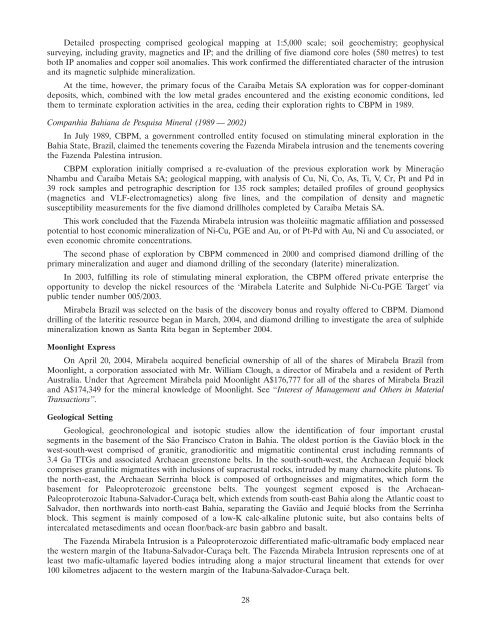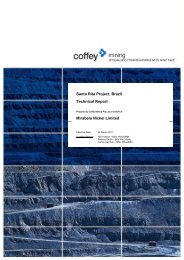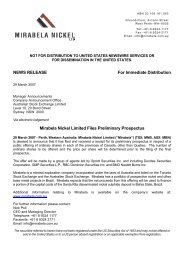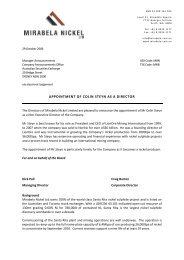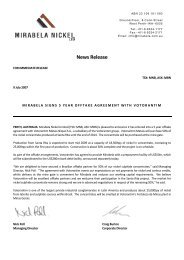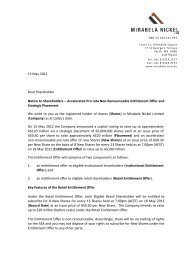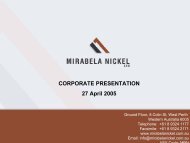COPY OF FINAL PROSPECTUS - Mirabela Nickel
COPY OF FINAL PROSPECTUS - Mirabela Nickel
COPY OF FINAL PROSPECTUS - Mirabela Nickel
Create successful ePaper yourself
Turn your PDF publications into a flip-book with our unique Google optimized e-Paper software.
Detailed prospecting comprised geological mapping at 1:5,000 scale; soil geochemistry; geophysical<br />
surveying, including gravity, magnetics and IP; and the drilling of five diamond core holes (580 metres) to test<br />
both IP anomalies and copper soil anomalies. This work confirmed the differentiated character of the intrusion<br />
and its magnetic sulphide mineralization.<br />
At the time, however, the primary focus of the Caraíba Metais SA exploration was for copper-dominant<br />
deposits, which, combined with the low metal grades encountered and the existing economic conditions, led<br />
them to terminate exploration activities in the area, ceding their exploration rights to CBPM in 1989.<br />
Companhia Bahiana de Pesquisa Mineral (1989 — 2002)<br />
In July 1989, CBPM, a government controlled entity focused on stimulating mineral exploration in the<br />
Bahia State, Brazil, claimed the tenements covering the Fazenda <strong>Mirabela</strong> intrusion and the tenements covering<br />
the Fazenda Palestina intrusion.<br />
CBPM exploration initially comprised a re-evaluation of the previous exploration work by Mineração<br />
Nhambu and Caraíba Metais SA; geological mapping, with analysis of Cu, Ni, Co, As, Ti, V, Cr, Pt and Pd in<br />
39 rock samples and petrographic description for 135 rock samples; detailed profiles of ground geophysics<br />
(magnetics and VLF-electromagnetics) along five lines, and the compilation of density and magnetic<br />
susceptibility measurements for the five diamond drillholes completed by Caraíba Metais SA.<br />
This work concluded that the Fazenda <strong>Mirabela</strong> intrusion was tholeiitic magmatic affiliation and possessed<br />
potential to host economic mineralization of Ni-Cu, PGE and Au, or of Pt-Pd with Au, Ni and Cu associated, or<br />
even economic chromite concentrations.<br />
The second phase of exploration by CBPM commenced in 2000 and comprised diamond drilling of the<br />
primary mineralization and auger and diamond drilling of the secondary (laterite) mineralization.<br />
In 2003, fulfilling its role of stimulating mineral exploration, the CBPM offered private enterprise the<br />
opportunity to develop the nickel resources of the ‘<strong>Mirabela</strong> Laterite and Sulphide Ni-Cu-PGE Target’ via<br />
public tender number 005/2003.<br />
<strong>Mirabela</strong> Brazil was selected on the basis of the discovery bonus and royalty offered to CBPM. Diamond<br />
drilling of the lateritic resource began in March, 2004, and diamond drilling to investigate the area of sulphide<br />
mineralization known as Santa Rita began in September 2004.<br />
Moonlight Express<br />
On April 20, 2004, <strong>Mirabela</strong> acquired beneficial ownership of all of the shares of <strong>Mirabela</strong> Brazil from<br />
Moonlight, a corporation associated with Mr. William Clough, a director of <strong>Mirabela</strong> and a resident of Perth<br />
Australia. Under that Agreement <strong>Mirabela</strong> paid Moonlight A$176,777 for all of the shares of <strong>Mirabela</strong> Brazil<br />
and A$174,349 for the mineral knowledge of Moonlight. See ‘‘Interest of Management and Others in Material<br />
Transactions’’.<br />
Geological Setting<br />
Geological, geochronological and isotopic studies allow the identification of four important crustal<br />
segments in the basement of the São Francisco Craton in Bahia. The oldest portion is the Gavião block in the<br />
west-south-west comprised of granitic, granodioritic and migmatitic continental crust including remnants of<br />
3.4 Ga TTGs and associated Archaean greenstone belts. In the south-south-west, the Archaean Jequié block<br />
comprises granulitic migmatites with inclusions of supracrustal rocks, intruded by many charnockite plutons. To<br />
the north-east, the Archaean Serrinha block is composed of orthogneisses and migmatites, which form the<br />
basement for Paleoproterozoic greenstone belts. The youngest segment exposed is the Archaean-<br />
Paleoproterozoic Itabuna-Salvador-Curaça belt, which extends from south-east Bahia along the Atlantic coast to<br />
Salvador, then northwards into north-east Bahia, separating the Gavião and Jequié blocks from the Serrinha<br />
block. This segment is mainly composed of a low-K calc-alkaline plutonic suite, but also contains belts of<br />
intercalated metasediments and ocean floor/back-arc basin gabbro and basalt.<br />
The Fazenda <strong>Mirabela</strong> Intrusion is a Paleoproterozoic differentiated mafic-ultramafic body emplaced near<br />
the western margin of the Itabuna-Salvador-Curaça belt. The Fazenda <strong>Mirabela</strong> Intrusion represents one of at<br />
least two mafic-ultamafic layered bodies intruding along a major structural lineament that extends for over<br />
100 kilometres adjacent to the western margin of the Itabuna-Salvador-Curaça belt.<br />
28


